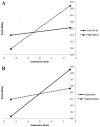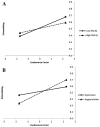Longitudinal associations between temperament and socioemotional outcomes in young children: the moderating role of RSA and gender
- PMID: 25399505
- PMCID: PMC4431540
- DOI: 10.1002/dev.21267
Longitudinal associations between temperament and socioemotional outcomes in young children: the moderating role of RSA and gender
Abstract
Temperament is an important predictor of socioemotional adjustment, such as externalizing and internalizing symptoms. However, there is not a one-to-one correspondence between temperamental predispositions and these outcomes, implying that other factors also contribute to the development of internalizing and externalizing problems. Self-regulation is believed to interact with temperament, and has been studied as a predictor for later socioemotional outcomes. Respiratory sinus arrhythmia (RSA) is a psychophysiological measure of self-regulation that has been studied as a moderator of risk. The primary aim of the present study was to test if RSA baseline and RSA reactivity would moderate the link between temperament and socioemotional outcomes. Mothers reported the temperament of their infants (20 months; N = 154), RSA was collected at 24- and 42-months, and mothers reported externalizing and internalizing behaviors at kindergarten entry. RSA baseline and RSA reactivity moderated the relation between exuberant temperament and externalizing behaviors. However, these results were only significant for girls, such that high RSA baseline and greater RSA suppression predicted more externalizing behaviors when exuberance was high. Fearful temperament predicted later internalizing behaviors, but no moderation was present. These results are discussed in light of recent evidence regarding gender differences in the role of RSA as a protective factor for risk.
Keywords: Emotion; Respiratory Sinus Arrhythmia; Sex Differences; Temperament.
© 2014 Wiley Periodicals, Inc.
Figures


Similar articles
-
Inhibitory control in typically developing preschoolers: Relations among temperament, respiratory sinus arrhythmia, and behavior at age 4.Dev Psychobiol. 2018 Nov;60(7):862-874. doi: 10.1002/dev.21740. Epub 2018 Jun 17. Dev Psychobiol. 2018. PMID: 29911319
-
Shyness, aggression, and empathy in children of shy mothers: Moderating influence of children's psychophysiological self-regulation.Dev Psychobiol. 2020 Apr;62(3):324-338. doi: 10.1002/dev.21918. Epub 2019 Sep 17. Dev Psychobiol. 2020. PMID: 31531858
-
Coregulation of respiratory sinus arrhythmia between parents and preschoolers: differences by children's externalizing problems.Dev Psychobiol. 2015 Dec;57(8):994-1003. doi: 10.1002/dev.21323. Epub 2015 May 14. Dev Psychobiol. 2015. PMID: 25976070 Free PMC article.
-
The Interaction Between Child Behavioral Inhibition and Parenting Behaviors: Effects on Internalizing and Externalizing Symptomology.Clin Child Fam Psychol Rev. 2018 Sep;21(3):320-339. doi: 10.1007/s10567-018-0254-9. Clin Child Fam Psychol Rev. 2018. PMID: 29464425 Review.
-
Respiratory sinus arrhythmia reactivity across empirically based structural dimensions of psychopathology: A meta-analysis.Psychophysiology. 2019 May;56(5):e13329. doi: 10.1111/psyp.13329. Epub 2019 Jan 23. Psychophysiology. 2019. PMID: 30672603 Free PMC article. Review.
Cited by
-
Are fearful boys at higher risk for anxiety? Person-centered profiles of toddler fearful behavior predict anxious behaviors at age 6.Front Psychol. 2022 Aug 8;13:911913. doi: 10.3389/fpsyg.2022.911913. eCollection 2022. Front Psychol. 2022. PMID: 36033082 Free PMC article.
-
Multidimensional Emotion Regulation Moderates the Relation Between Behavioral Inhibition at Age 2 and Social Reticence with Unfamiliar Peers at Age 4.J Abnorm Child Psychol. 2019 Jul;47(7):1239-1251. doi: 10.1007/s10802-018-00509-y. J Abnorm Child Psychol. 2019. PMID: 30737661 Free PMC article.
-
Annual Research Review: Developmental pathways linking early behavioral inhibition to later anxiety.J Child Psychol Psychiatry. 2023 Apr;64(4):537-561. doi: 10.1111/jcpp.13702. Epub 2022 Sep 19. J Child Psychol Psychiatry. 2023. PMID: 36123776 Free PMC article. Review.
-
Childhood Family Stress and Women's Health: Parasympathetic Activity as a Risk and Resiliency Factor.Appl Psychophysiol Biofeedback. 2024 Dec;49(4):677-694. doi: 10.1007/s10484-024-09661-2. Epub 2024 Aug 23. Appl Psychophysiol Biofeedback. 2024. PMID: 39179946
-
Toddler Exuberance as an Influence on Positive Social Behavior in a High-Intensity Context in Middle Childhood.Soc Dev. 2022 Feb;31(1):232-247. doi: 10.1111/sode.12532. Epub 2021 Jul 15. Soc Dev. 2022. PMID: 35330663 Free PMC article.
References
-
- Aiken LS, West SG. Multiple regression: Testing and interpreting interactions. SAGE; 1991.
-
- Armstrong JM, Goldstein LH, The MacArthur Working . In: Group on Outcome Assessment. Chair. Manual for the MacArthur Health and Behavior Questionnaire (HBQ 1.0) Kupfer David J., editor. University of Pittsburgh; Pittsburgh: 2003.
-
- Beauchaine T. Vagal tone, development, and Gray’s motivational theory: Toward an integrated model of autonomic nervous system functioning in psychopathology. Development and Psychopathology. 2001;13(2):183–214. doi: 10.1017/S0954579401002012. - PubMed
-
- Beauchaine TP, Katkin ES, Strassberg Z, Snarr J. Disinhibitory psychopathology in male adolescents: Discriminating conduct disorder from attention-deficit/hyperactivity disorder through concurrent assessment of multiple autonomic states. Journal of Abnormal Psychology. 2001;110(4):610–624. doi: http://dx.doi.org.ezaccess.libraries.psu.edu/10.1037/0021-843X.110.4.610. - DOI - PubMed
MeSH terms
Grants and funding
LinkOut - more resources
Full Text Sources
Other Literature Sources

